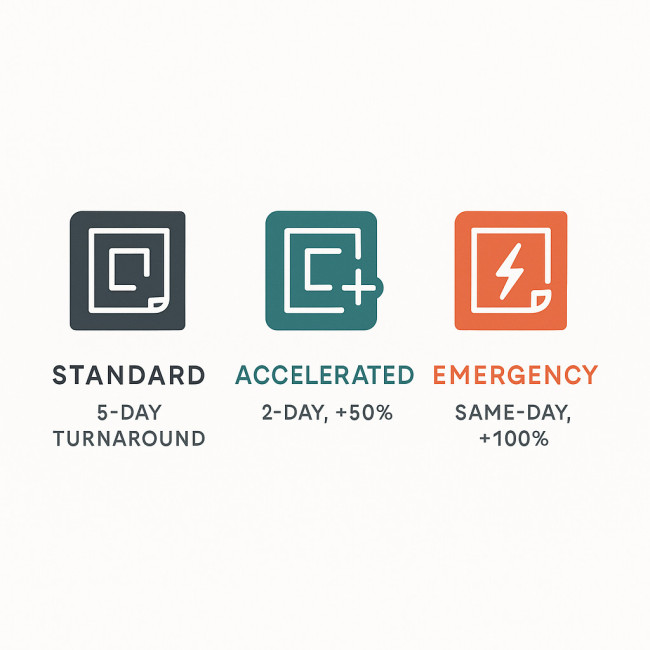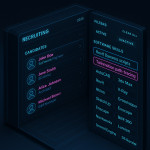Setting rush fees: balanced surge pricing for last-minute draftsman requests
Late-night emails asking for “permit drawings by tomorrow” are flattering, but they can burn you out if you do not charge fairly for the scramble. This guide shows draftsmen how to introduce transparent rush fees, calculate balanced surge pricing, and communicate value so clients accept the premium instead of haggling.
The business case for a rush fee

A rush fee (also called a rush surcharge or surge pricing) compensates you for three hidden costs: re-prioritising your queue, higher error risk under time pressure, and the personal impact on evenings or weekends. According to a 2023 Freelancers Union poll, 71 % of technical illustrators who set rush fees reported higher overall client satisfaction because deadlines were met without hidden overtime.
- Protects your average hourly rate when you work unsociable hours.
- Encourages clients to brief earlier the next time.
- Signals professionalism—clear policies reassure architectural firms evaluating draftsman brief templates.
Industry benchmarks for rush surcharges
Most architecture support studios apply a sliding scale. Below are typical figures gathered from agency rate cards, online marketplaces, and union guidelines.
| Notice period | Common surcharge | Example: base €40/h |
|---|---|---|
| > 5 business days | 0 % | €40/h |
| 3 – 5 business days | 25 % | €50/h |
| 1 – 2 business days | 50 % | €60/h |
| < 24 h (same day) | 75 % – 100 % | €70 – €80/h |
| Weekend or public holiday | 100 % – 150 % | €80 – €100/h |
Notice how the rush fee climbs steeply inside the final 24 hours. Clear tiers give procurement teams predictable costs and make your rush fee easier to defend versus ad-hoc quotes.
How to calculate your own balanced rush fee
1. Start with your true cost of overtime
Add together your standard hourly rate, the opportunity cost of delaying other jobs, and any out-of-pocket expenses (for example, express print delivery).
2. Choose a surcharge model that fits
- Percentage uplift – simplest to explain (“+50 % for next-day delivery”).
- Fixed fee – useful for small jobs (“€200 rush flat rate up to 10 sheets”).
- Hybrid – flat fee for mobilisation plus percentage on hours.
3. Sanity-check against client value
If the client saves a €10 000 penalty by getting drawings certified on time, your €750 rush fee is proportionate. Demonstrating that logic turns a cost into an investment.
Communicating rush fees without scaring clients
- Publish the policy on your rate card and on your professional directory profile. Transparency avoids surprises.
- Add a countdown clause: “Rush fee applies when final files are required within 48 hours of brief approval.”
- Bundle value: include priority revisions or an extra QC pass so the premium feels justified.
- Reference capacity limits: if you are already near 100 % utilisation, the rush fee naturally climbs. Linking to your skill-mapping profile can illustrate workload scope.
Template clause for your next contract
“Work commencing within 24 (twenty-four) hours of written brief approval is classified as ‘rush service'. A surge fee of 75 % of the base labour rate will be applied to all hours logged until the submitted deliverables are accepted in writing. Rush service hours are billed in full at project close.”
Negotiation tips: when clients push back
Even seasoned project managers may not understand the ripple effect of last-minute changes. Use the following talking points:
- “The rush fee secures exclusive focus on your drawings, minimising the risk of permit rejection.”
- “Our surcharge is lower than typical overnight courier or re-inspection charges.”
- Offer alternatives: partial delivery or phased handover at a lower premium.
Case study: reducing pushback with tiered offers

Laura, a freelance draftsman in Lyon, introduced three service levels: Standard (5-day), Accelerated (2-day, +50 %), and Emergency (same day, +100 %). Within two months, 40 % of her clients shifted from informal haggling to selecting a tier up-front, and her after-hours workload dropped by 15 %. She now signs more retainer agreements because clients appreciate her structured workflow.
Rush fee do's and don'ts
- Do log rush hours separately in your time-tracking tool.
- Do add a note on every invoice line item explaining the trigger.
- Do waive the fee only for strategic, high-lifetime-value clients—and only once.
- Don't spring the fee after the fact; always confirm in writing before work starts.
- Don't lower quality checks to meet speed; errors cost more than the surcharge earns.
Maintaining healthy work-life balance
A fair rush fee protects not just revenue but wellbeing. Set a hard cap on the number of emergency jobs per month. When your schedule is full, confidently decline or refer the enquiry to peers inside the remote drafting network you trust. Clients value honest capacity signals over missed deadlines.
FAQ
- Should I charge a rush fee for revisions or only for initial delivery?
- Apply the surcharge whenever the turnaround time falls inside your defined rush window, whether it is a first draft or a last-minute redline set.
- Can I advertise “no rush fee” as a competitive advantage?
- You can, but you risk training clients to brief late and eroding your standard rate. Most seasoned professionals prefer transparent tiers.
- What if a long-term client refuses any surcharge?
- Offer a moderate discount on the rush fee, but keep the principle. Otherwise postpone other work and risk upsetting additional clients.
- How do I handle rush requests during vacation?
- Double the usual surcharge or subcontract. Your policy should state that availability is not guaranteed during published leave periods.
Key takeaways
- Publish notice-period tiers so clients self-select service speed.
- Base your rush fee on actual overtime cost plus client value saved.
- Bundle quality assurances to frame the surcharge as risk mitigation.
- Use clear contract clauses and upfront communication to prevent friction.
Ready to act?
Add a rush-fee line to your rate sheet today and update the service section of your directory profile. When the next “urgent” email lands, you will be prepared to say “Yes—here is the accelerated rate” with confidence.
Need help refining your pricing grid? Contact us for a 30-minute strategy call and start commanding premium fees without burning out.











